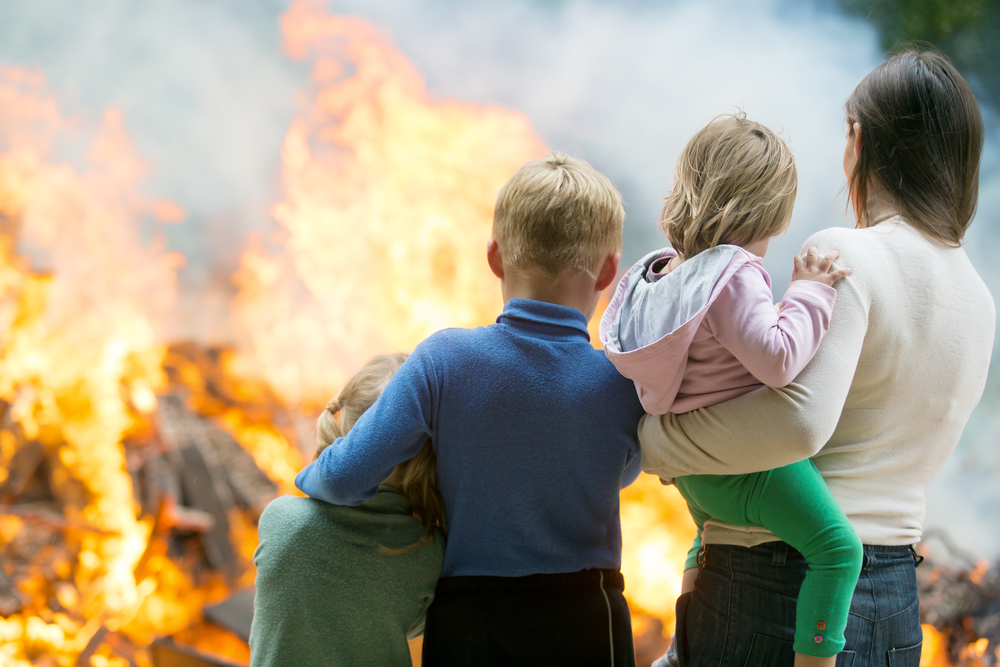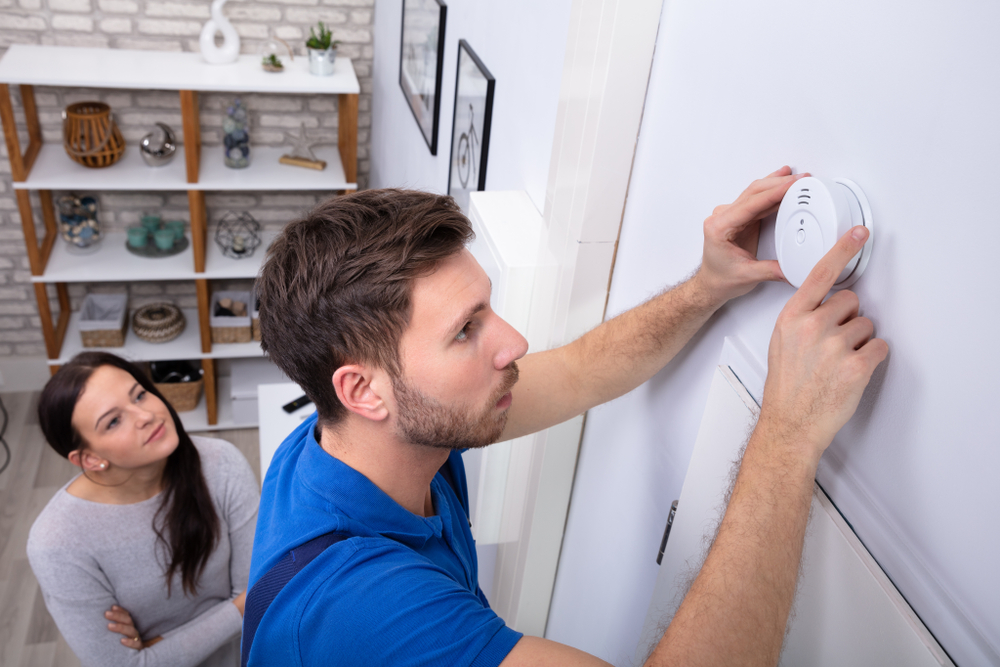Home Fire Safety Tips: How to Prevent a Fire at Home

Home fires are nothing to take lightly, and when disaster strikes, time is of the essence. Within two short minutes, a seemingly manageable cooking fire can evolve into a life-threatening emergency. Within five minutes, flames can engulf an entire home. Not only can house fires incur catastrophic damages, but they can cost lives.
In America, 2,500 people die each year in house fires, according to the National Fire Protection Association (NFPA). Coupled with an annual average of 12,300 civilian injuries and nearly $7 billion in direct damage costs, home fires pose a severe and unpredictable threat to you, your property, and your community.
The good news is that house fire deaths are dropping year over year thanks to increased fire safety awareness. But knowledge alone isn’t enough to lower your chance of a household blaze. Protecting your family and your home from an accidental fire begins with prevention. This guide will walk you through the common causes of home fires, and the best ways to protect your property.
Fast Facts about Fire
Before we dive into the nitty-gritty details of home fire safety, it’s important to know what you’re up against. When faced with a household fire, you’ll need to think fast and act without hesitation to ward off the inevitable danger of a growing fire. Here’s what you need to know:
- Fact #1: It’s hot
This may sound obvious, but many people don’t realize how hot a fire in your home can be. In fact, the heat generated is more life-threatening than the flames themselves. In mere seconds, room temperatures can reach 100 degrees at floor level and blaze up to 600 degrees at eye level. Inhaling heat this extreme can scorch your lungs and melt clothing into your skin. - Fact #2: It’s fast
Don’t make the mistake of underestimating a fire’s speed of spread — the faster you act, the better your outcome. Within 60 seconds, a small flame can transform into a massive inferno. - Fact #3: It’s dark
When a fire first breaks out, it carries a bright yellow-orange color. However, this quickly turns into thick, black smoke that can immerse your home in total darkness. - Fact #4: It’s deadly
Smoke and toxic gas inhalation are deadlier than fire flames. Inhaling the poisonous air emitted from fires can cause disorientation. And, if your respiratory system absorbs enough fine particles, it can lead to fatal asphyxiation.
What are the Most Common Causes of Home Fires?
The first step toward prevention is understanding the most common causes of house fires. By identifying these accidental causes, you can lower your risk by implementing smarter, safer practices.
Cooking fires
Cooking fires are the number one type of home fire, accounting for around 50.7% of all annual residential fires in the U.S. These fires often result from grease that’s overheated on a stove or inside an oven. When grease reaches about 600 degrees, it can spontaneously combust, even without directly contacting a flame. Ultimately, once a grease fire has ignited, it can be nearly impossible to extinguish.
Home fire safety tips to prevent a cooking fire:
- Never leave food unattended while cooking
- Turn handles on pots and pans inward to avoid any accidental bumping
- Keep your cooking space clean and clear of an open flame
- Install a smoke detector near (but not in) in the kitchen
- Unplug electric appliances when they’re not in use
Heating appliance fires
Space heaters are to blame for an estimated 25,000 annual residential fires, reports the U.S. Consumer Product Safety Commission. Regardless of whether your space heater is fueled by kerosene or electricity, all heating appliances must be handled and attended to with care. Whether it’s faulty wiring or too-close of contact with nearby fabrics, there are a number of ways a space heater can lead to a blaze.
Home fire safety tips to prevent a heating appliance fire:
- Follow the instructions in your heating device manuals to ensure proper use
- Never leave a running space heater unattended
- Unplug your space heater when it’s not in use
- Keep heaters away from any flammable materials (i.e. furniture, curtain, blankets)
- Do not place heating appliances in enclosed areas
Electrical fires
The modern home depends on several different electrical wiring systems to operate. A report issued by the U.S. Fire Administration found that electrical malfunction accounted for 6.8% of all residential building fire causes in 2018. Many electric fires are caused by one of two scenarios: either short circuits spark and ignite building materials, or current-overloaded circuits lead to overheated wires. Oftentimes, electrical fires erupt in hidden locations without a homeowner seeing, smelling, or hearing anything go awry — making them some of the deadliest.
Home fire safety tips to prevent an electrical fire:
- Unplug heat-producing appliances when they’re not in use
- Never plug in devices with damaged power cords
- Survey power cords to ensure they are not frayed, cracked, placed underneath rugs, or stationed in high traffic areas
- Only use extension cords as temporary wiring fixes
- Check for loose-fitting outlets and replace any missing or broken wall plates
Chemical fires
Residential chemical fires often occur when explosive vapors from flammable liquids — fuels, solvents, adhesives, thinners, paints, and cleaning agents — either reach a flash-point temperature or come in contact with an open flame. A single spark of electricity near any number of these chemical compounds can ignite a roaring house fire within seconds.
Home fire safety tips to prevent a chemical fire:
- Store all flammable chemical products in cool areas
- Tightly seal containers to prevent vapor leakage
- Store containers at least 50 feet away from ignition sources
- Maintain adequate ventilation wherever chemicals are stored
Home Fire Safety Tips to Know
Tip #1. Test your smoke detector
An astounding three out of five home fire fatalities happen in homes without a smoke detector or with broken smoke alarms. Smoke detectors are an essential first indicator of a home fire; without a functional alarm, a blaze could ignite and spread without your knowledge.
The vast majority of houses are furnished with smoke detectors, but if you live in an old home (or if your detector is more than 10 years old), you may need to install a few more.

Testing your smoke detector is simple — hold down the “test” button until you hear two beeps. Once they’ve sounded, release your finger from the button and repeat the process. During the second trial, you should hear four beeps. These noises indicate that your smoke alarm is good to go.
Pro-tip: Test smoke detectors monthly and be sure to replace batteries at least once a year.
Tip #2. Create an escape plan
As you’re now aware, household fires can spread instantly, and every second counts to ensure your family’s safety. Creating a fire escape plan is a crucial step to prepare for any type of disaster. Establish a standardized plan of action that every family member can follow, and be sure to practice it regularly.
Begin devising your plan by drawing a map of your home and following these escape plan guidelines from the NFPA:
- Identify two ways to escape from each room in your house.
- Make sure all doors and windows leading outside open easily and are free of any potential obstruction.
- If there are any infants, older adults, or family members with mobility limitations in your home, assign someone to assist them during emergencies.
- If you live in a multi-story home, make sure everyone knows to use the stairs — never the elevator.
- Designate an outdoor meeting place a safe distance from the property where everyone should gather after escaping.
Tip #3. Learn how to use a fire extinguisher
Some homes come furnished with a fire extinguisher, some don’t. If you have one, be sure everyone knows how to properly use it. Household fire extinguishers are designed to smother flames in the incipient stage, or when the fire has just erupted. However, there are several classes of fire extinguishers that are engineered to suffocate different types of fires. Make sure you know what kind of fire extinguisher you have:
- Class A - Solid combustibles (i.e. wood, cloth, paper products)
- Class B - Flammable liquids and gases
- Class C - Electrical fires
- Class D - Flammable metals
- Class K - Oil and grease
If a small fire has broken out, remember the acronym PASS to efficiently snuff out the flames:
- Pull the pin
- Aim low at the base of the fire
- Squeeze the handle slowly
- Sweep the nozzle side to side
Tip #4. Educate your kids
One of the best ways to prepare your family for an unexpected fire emergency is by educating them on how to handle the situation before it arises. Children should know exactly what to do if a house fire erupts, and they should understand how to practice fire safety.
Here are some basic fire safety tips:
- Teach them how to “Stop, Drop, and Roll” by doing it with them and then have them demonstrate for you.
- Show them how to crawl on their hands and knees if they see or smell smoke and to alert an adult immediately.
- Make sure they know not to hide under their bed or in the closet during a fire.
- Teach them not to walk into any room without touching the doorknobs first. If there’s heat, it’s not safe to enter.
Be Proactive Today, Prevent a Disaster Tomorrow
A household fire could strike at any time — but you can help prevent a catastrophe by being proactive. Follow these fire safety tips to prevent chemical and electrical fires, and any blazes that might erupt in the kitchen and from your heating appliances. Make sure your HVAC system is functioning properly, and that your hot water heater is safe from a dangerous explosion. Leaky ductwork can lead to water damage in your walls and put your home at risk of an electrical fire.
If you need to fix or replace these household systems, Ygrene’s PACE financing can help you pay for energy-efficient upgrades for no money down, and no payments for 12 months or longer. Find out if PACE is available in your area, and protect your home and your family against a potential house fire.




